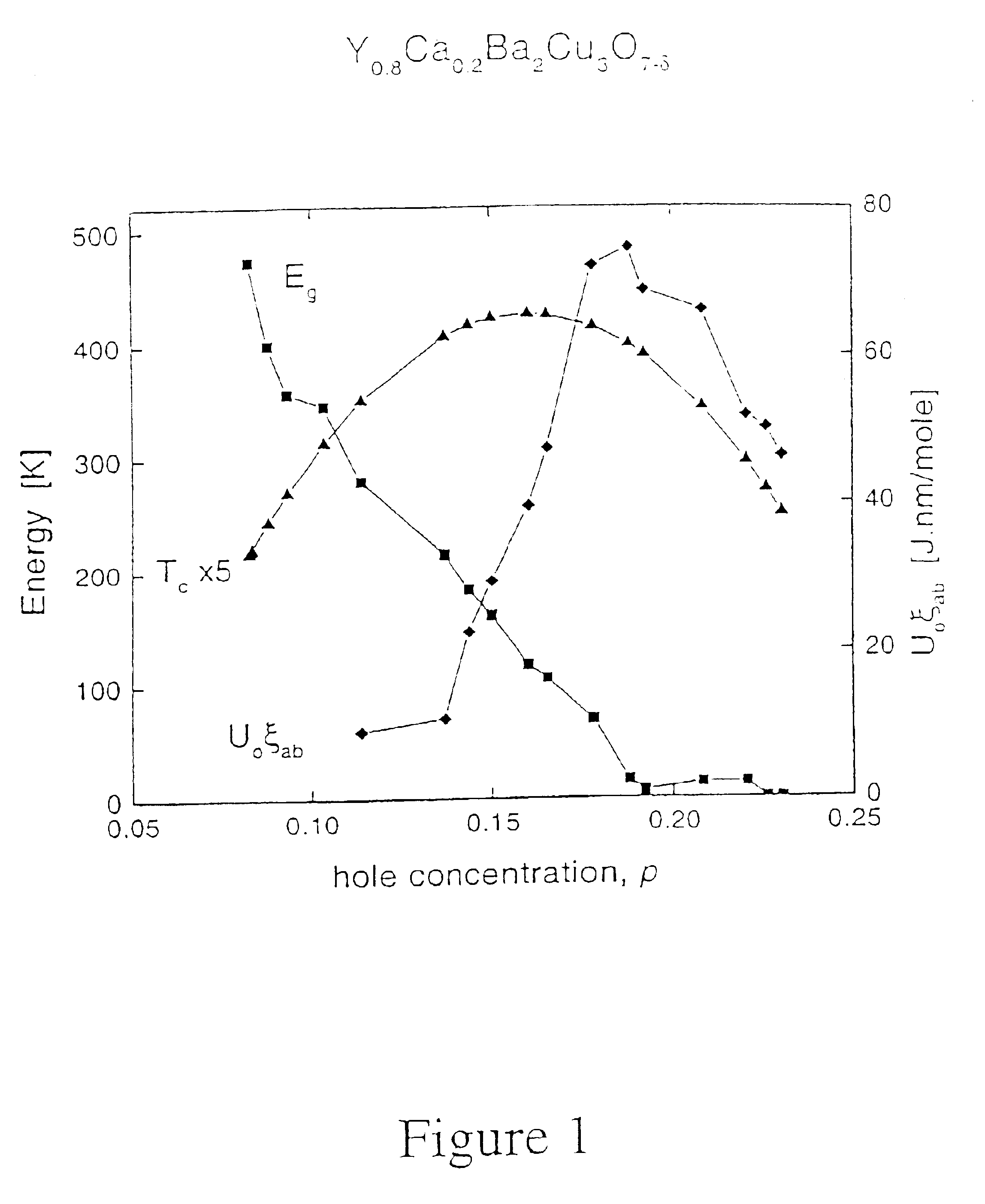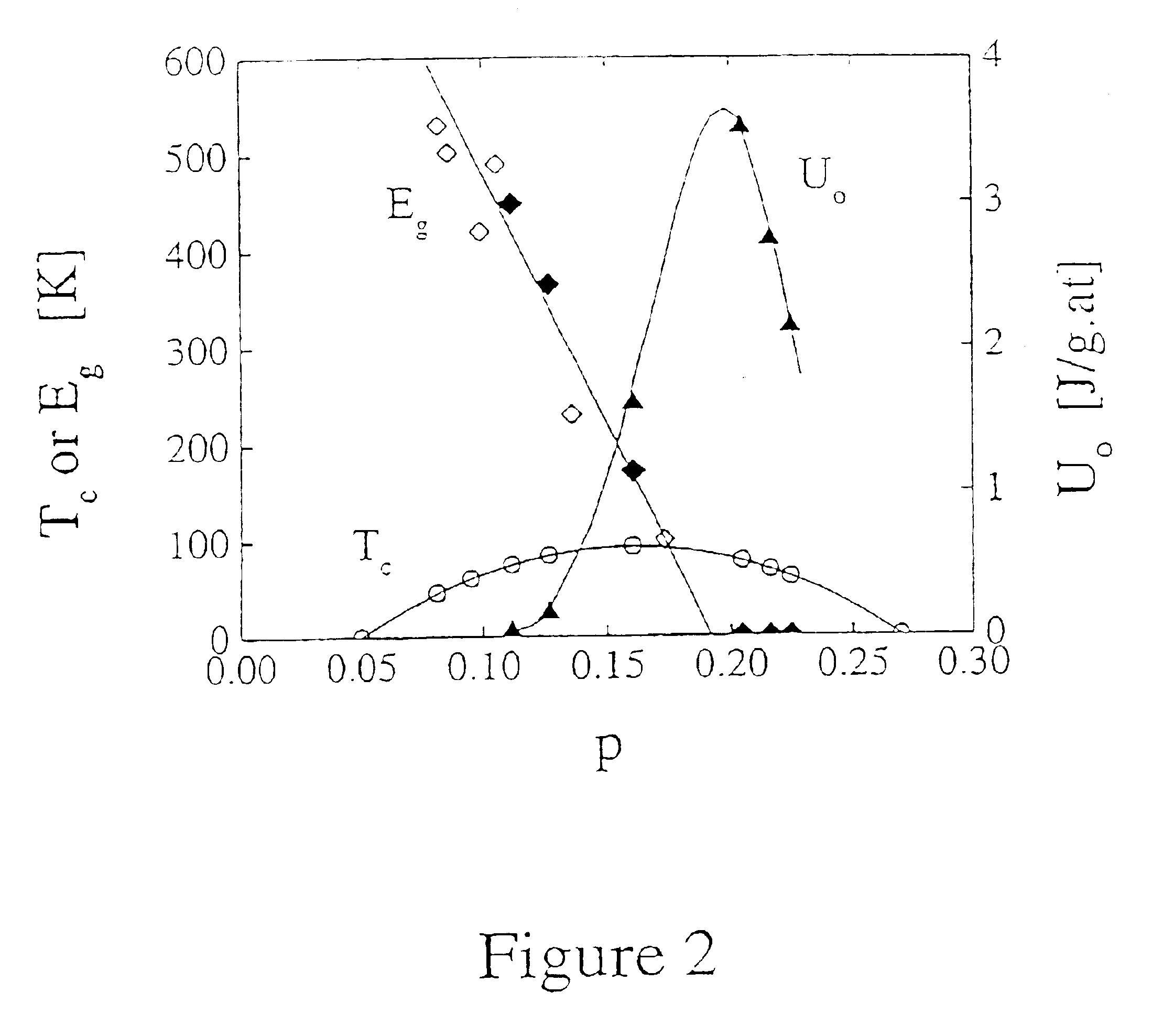Critical doping in high-Tc superconductors for maximal flux pinning and critical currents
a superconductors and flux pinning technology, applied in the direction of superconductors, superconducting magnets/coils, magnetic bodies, etc., can solve the problems of not ensuring the utility of htsc, high critical current in the presence of magnetic fields, etc., to increase the critical current density of materials and maximize critical current density.
- Summary
- Abstract
- Description
- Claims
- Application Information
AI Technical Summary
Benefits of technology
Problems solved by technology
Method used
Image
Examples
example 1
Samples of Y.sub.0.8 Ca.sub.0.2 Ba.sub.2 Cu.sub.3 O.sub.7-.delta. were investigated as a function of oxygen deficiency, .delta., using heat capacity, C.sub.p, and NMR spectroscopy. This HTS material is especially useful because its doping state may be altered from heavily underdoped to heavily overdoped as .delta. is altered from 1 to 0. The hole concentration was determined using the thermoelectric power correlation between Q(290) and p (Tallon et al., U.S. Pat. No. 5,619,141). The values were found to agree well with values determined from the parabolic relationship between T.sub.c and p T.sub.c (p)=T.sub.c,max.multidot. [-82.6 (p-0.16).sup.2 ] and also from estimates of p using bond valence sums from neutron diffraction refinement of atomic coordinates. T.sub.c,max is the maximum in the approximately parabolic hole-concentration dependence of T.sub.c (p). The pseudogap energy, E.sub.g, was determined from fitting the temperature dependence of the entropy and values were confirmed...
example 2
Samples of overdoped Bi.sub.2 Sr.sub.2 CaCu.sub.2 O.sub.8+.delta. with different .delta. and underdoped Bi.sub.2 Sr.sub.2 Ca.sub.0.7 Y.sub.0.3 Cu.sub.2 O.sub.8+.delta. with different .delta. were substituted with a range of Co on the Cu site. From the rate of impurity depression of T.sub.c, dT.sub.c / dy, due to the fraction y of Co one may determine the value of the value of .gamma.=C.sub.p / T at T=T.sub.c. Using scaling relations (Tallon, Phys. Rev. B-58, R5956 (1998) one may thence determine E.sub.g and U.sub.o which are plotted in FIG. 2 by the filled symbols. The open triangles are the values of E.sub.g determined for Y.sub.0.8 Ca.sub.0.2 Ba.sub.2 Cu.sub.3 O.sub.7-.delta. from NMR measurements and these show that the two methods give comparable results for E.sub.g. Again one may see that for Bi.sub.2 Sr.sub.2 CaCu.sub.2 O.sub.8+.delta., as in Y.sub.0.8 Ca.sub.0.2 Ba.sub.2 Cu.sub.3 O.sub.7-.delta., U.sub.o passes through an unexpectedly sharp maximum in the lightly overdoped regi...
example 3
Samples of Y.sub.0.8 Ca.sub.0.2 Ba.sub.2 Cu.sub.3 O.sub.7.delta. were investigated as a function of oxygen deficiency, .delta., using muon spin relaxation. The muon spin relaxation rate at T=0, .sigma..sub.o, is proportional to .lambda..sub.L.sup.-2. FIG. 3 shows a plot of .lambda..sub.L.sup.-2 as a function of hole concentration, P. .lambda..sub.L.sup.-2. may be seen to pass through a sharp maximum at the critical point p.apprxeq.0.19 where E.sub.g becomes zero. .lambda..sub.L.sup.-2 is a key parameter in determining the magnitude of the irreversibility field. As a consequence critical doping at p.apprxeq.0.19 not only sharply maximises flux pinning but will result in high irreversibility fields.
PUM
| Property | Measurement | Unit |
|---|---|---|
| temperature | aaaaa | aaaaa |
| temperature | aaaaa | aaaaa |
| Tc | aaaaa | aaaaa |
Abstract
Description
Claims
Application Information
 Login to View More
Login to View More - R&D
- Intellectual Property
- Life Sciences
- Materials
- Tech Scout
- Unparalleled Data Quality
- Higher Quality Content
- 60% Fewer Hallucinations
Browse by: Latest US Patents, China's latest patents, Technical Efficacy Thesaurus, Application Domain, Technology Topic, Popular Technical Reports.
© 2025 PatSnap. All rights reserved.Legal|Privacy policy|Modern Slavery Act Transparency Statement|Sitemap|About US| Contact US: help@patsnap.com



